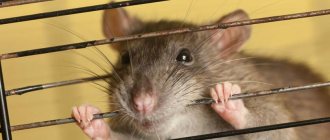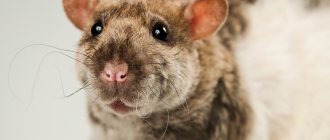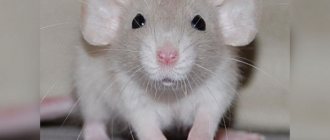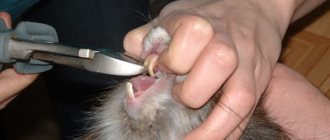Rats are considered quiet animals, but this is far from the truth. They can make a wide variety of sounds, which often impress people.
Pet rats make all sorts of noises that can sometimes sound a little strange. With these sounds they try to let the owner know about something: joy, anger, irritation or poor health. As a rat owner, it is very important for you to know the difference between these noises. This will help you understand your pet better.
What sounds do domestic and wild rats make?
Under natural conditions, rodents live in colonies and communicate in three complementary ways:
- High frequency sounds. Used by cubs to find their mother or by males during the mating season. The human ear is not able to recognize this signal.
- Chirping. Rapid rhythmic chattering of teeth is used to warn relatives of approaching danger. A domestic rat can also chirp if it is scared.
- Smells. They play a key role, since the rat’s sense of smell is more developed than other senses. Wild animals mark their territory with scent glands, and also recognize relatives by a specific smell.
Reference! Rats are myopic, so visual perception does not play a key role for them.
As they became domesticated, people learned to distinguish and identify some of the sounds of their pets.
Nocturnal lifestyle
Wild rats are active at night, and during the day they rest in a shelter. Pets can be adapted to human routines, but this will require patience and focused training on the part of the owner. The best time for games and training is after 20:00.
Some owners of pet rodents communicate with the animals in the early morning. It all depends on the type of rat, its individual characteristics, and the degree of contact. If you do not work with the animal, the animal will sleep during the day.
Squeak
With the help of a piercing loud squeak, the animal tries to convey its fear or pain. Inspect the area around the cage and analyze what might have frightened your pet. It is likely that the rat could hear the cat or the hum of the vacuum cleaner from the next room.
If the rat does not live alone in the cage, put it away. Inspect carefully for bites and injuries. If there are no visible signs of damage on the body, and the pet does not calm down and continues to squeak for a long time, contact your veterinarian immediately. Your pet may experience severe pain due to internal injuries.
A quiet, barely audible squeak from stroking means that the rodent enjoys communicating with the owner.
An abrupt loud squeak when pulled out of the cage signals that the pet is not in the mood to contact a person.
Meaning of beeps
How does a rat squeak? - extremely diverse. The rather rich tongue of a rodent signals that the animal is afraid, in pain, indignant, happy at the appearance of its owner, etc. The only way for a pet to express its emotions is through sound signals.
In order to know why a rat squeaks, every attentive owner must learn to decipher the sounds made by the pet:
- If a rat screams for a long time or squeals heart-rendingly , it means that it is in great pain. It is necessary to examine the animal and identify the cause of the pain, be it damage from a sharp object or a wound received in a fight with a fellow animal. If there are no external wounds, you need to seek the help of a veterinarian - the internal organs of the rodent may be damaged;
- if the owner hears a hoarse squeak , then the animal is either angry or aggressive. As a rule, such a signal is aimed at intimidating the opponent. At this time, the rat is unlikely to like being disturbed, so you need to give it time to “cool down” and calm down;
- if the animal hisses , then this is also a signal of aggression and hostility. Most likely, it declares to its fellows its territorial rights or the rights to mate with the chosen female;
- if an animal chirps , then it is probably scared and warns community members about potential danger;
- but the pet grunts because it rejoices and experiences complete satisfaction;
- From the same positive emotions, a rodent can grind its teeth ;
If your pet rat squeaks strangely, either coughing or sneezing, it most likely has a cold and the animal needs treatment. In this case, be sure to show the animal to the veterinarian.
Article on the topic: Why do rats have a long hairless tail?
Can pet rats hiccup?
Hiccups in an animal occur against the background of:
- overeating;
- nervous excitement;
- hypothermia;
- helminthic infestation.
If the case of hiccups is isolated, then there is no need to worry - perhaps the rat has simply eaten too much. If attacks of hiccups occur periodically, then you need to think about changing food and carrying out preventive deworming.
Important! When hiccups are accompanied by heavy, wheezing breathing, take your pet to the vet immediately. There is a high risk of pneumonia or pneumonia. Without proper treatment, this can lead to the death of your pet.
Scavenger hunt
The desire to create reserves, deeply rooted in the rat’s nature, sometimes leads tailed pranksters to the trash can. If the owner does not have the habit of closing the container with a lid and often lets the animal walk around the house on its own, he should be prepared for the inevitable - the animal will get into the habit of carrying objects from the trash heap.
Most rats will pick up and take back to their nest anything that can be chewed. These can be wooden, plastic, rubber objects, pieces of fabric. Rodents masterfully arrange stashes of food reserves; they are quite difficult to find. In order to have such closets, the animal must have a certain amount of time when the control of the owners is completely absent.
What sounds indicate health problems?
“Pigeon” cooing occurs with various diseases of the respiratory system (colds, rhinitis, runny nose), less often with cardiac dysfunction. The animal needs a veterinary examination and selection of comprehensive treatment.
Grunting sounds can be a sign of a deviated nasal septum, rhinitis, or even pneumonia. But don’t be alarmed in advance—in some cases, the rat may grunt with pleasure. For example, receiving a desired treat or affection from a person.
Fights
It has been noticed that rats can box. Typically, two adult males behave this way when they compete for hierarchical status in a rat community. The animals stand on their hind legs and strike each other with their forelimbs.
Researchers confirm that social pyramids are formed within rat clans, headed by alpha males. Fights in which animals measure their strength are typical for this type of rodent. Brawls can occur, for example, when an older young rat asserts its rights to the highest rank in the hierarchy.
Sometimes fights between rodents arise due to intrusion into someone else's territory. Animals jealously protect their habitat. If you add a new inhabitant to the cage of an old-timer rat and do not first introduce the animals in a separate area, a fight cannot be avoided.
Young rats, especially females, get used to newcomers most easily. With adult males the situation is much more complicated; in most cases they begin to measure their strength.
Can a rat scream?
A heart-rending squeal, scream, or, as it is also called, “crying” of a rat is a sign that the animal is very scared or in pain.
If there are no objective reasons for panic, and the pet continues to scream, carefully remove it from the cage and feel its body with your finger. As a rule, when a person touches a sore spot, the rodent begins to scream louder.
Note! In some cases, a rat may experience pain due to internal injuries to the esophagus after eating inappropriate foods.
Screech
A loud squeal or scream as if it is being killed is also called a rat's "cry." It indicates severe pain or fear of the rodent.
As in the case of squeaking, it is necessary to palpate the pet’s body. If, when you touch any place without visible external injuries, the animal begins to scream, you must take it to the veterinarian. Pain can be caused by internal injuries to the digestive tract as a result of feeding foods that are unsuitable for the rodent.
If you find any kind of injury in a rat (skid, cut), you need to provide it with first aid yourself: treat the wound with an antiseptic solution and stop the bleeding.
What sound does a wounded animal make?
May scream, chirp, or remain silent due to painful shock. Most often, domestic rats suffer injuries to their paws: a torn claw, a cut, a splinter, a broken toe or tail, or a pinched tail.
If you find that your pet has injured itself, calm down, don’t panic, give it first aid. Treat the wound with an anti-inflammatory agent. Try to stop the bleeding with hydrogen peroxide.
Tail movements
One of the main indicators of a rat’s mood is the “behavior” of its tail. An attentive observer will be able to accurately determine the emotional state of his pet if he pays attention to the longest part of his body.
Table 2. How to decipher rat tail movements.
| Nature of movement | What does it mean |
| Lightly swings left and right | The rat is in good spirits, glad to see the owner |
| The tail twitches or freezes in a static position, often quite unnatural | Anxiety, defensiveness |
| Swings in both directions, range of motion is quite large | The animal is stressed and very scared. Perhaps the animal is in an inadequate condition |
The behavior of rats in the search mode differs significantly from their behavior in a calm state. At the same time, sick animals can be distinguished by slow movements and a “lifeless” tail dragging along the floor.
A healthy rat is usually very curious. She enjoys exploring her surroundings. If a rodent is interested in something, it usually rises on its hind legs and sucks in air through its nose. The rat's tail is slightly tense and sometimes motionless.
The animal can enthusiastically turn its head while searching for an interesting object. In this state, the rat turns on all external analyzers, examines visible objects, sounds, and smells.
The rat makes strange noises: what should I do?
Sounds that are unusual for humans are not always something unnatural. Sometimes a rat tries to attract attention, get a treat, or announce danger in this way. Guided by the description of each sound, you can easily understand what your pet is trying to say.
If you suspect that the animal is unwell and needs medical attention, do not delay visiting the veterinarian.
It’s not difficult to learn to feel your pet’s mood if you give him a couple of hours of free time every day. Follow the habits of the rat, try to understand the logic of its actions. Then you will easily understand the sounds that the rat makes and what it is trying to communicate to you in this way.
Great article 24
Choosing an ultrasonic repellent device
The practice of fighters against rats and mice shows that repellers that cost more than 1,000 rubles work reliably. In the case of these devices, the price quite well reflects the level of quality: cheaper than 1000 rubles, they usually sell obvious junk, sometimes only simulating work by flashing LEDs.
Moreover, special tests were carried out on several dozen devices on basement and free-living rats in abandoned enterprises. It turned out that powerful and more or less reliable means that can repel pests are:
- Chiston 2 (its price is approximately 2,200 rubles);
- Chiston 2 PRO (costs about 2,500 rubles);
- Bioguard (4500 rubles);
- TM-315 (costs more than 10,000 rubles);
- WK-0600 (7500 rubles);
- UZU-03 (costs about 3,000 rubles);
- Spectrum (3500 rubles);
- Tornado 800 (popular device, price approximately 3,500 rubles);
- Tsunami-2 (the cheapest on the list, costs just under 2,000 rubles);
- KQ-202 A (about 8,000 rubles).
The photo below shows the Chiston 2 repeller:
And here is Tornado 800:
These devices are more likely to scare away rats from a large apartment or from a medium-sized private house, from a basement or technical room. However, even they sometimes do not give a visible effect.
On a note
You can also scare a rat using an ultrasonic dog shocker. However, you won’t be able to use this product all the time, since it drains the battery too quickly.
Sometimes devices from the Elektrokot, Grad, and Typhoon brands work, and sometimes they don’t help. They look effective in reviews on YouTube when the device is turned on directly in a mouse cage, but in a large house the power of the repeller may not be enough.
It is also useful to read: Rat Death Poison No. 1: instructions for use and reviews of the product
Behavioral features
Rats detect any changes in the owner's voice, so raising your voice or using brute force for punishment is not acceptable. A frightened animal will become downtrodden and wild.
Try turning the guilty rodent onto its back. In nature, such punishment is used by the leader of the pack, so the rat realizes guilt and is filled with respect.
The only punishment for a rodent is to turn it over into a subordinate position
With a good attitude, the pet becomes imbued with love and begins to show talkativeness (coos, chirps, grunts). But even in this case, all sounds have their own interpretation and contain an obligatory subtext.
Bulging eyes
Some owners of decorative rodents begin to worry about their pets if their eyes protrude forward. As a rule, this occurs during grinding of teeth.
Experts advise not to attach importance to the bulging eyes of a rat that is sharpening its incisors. After all, after the end of the process, the appearance of the animal becomes the same.
Interesting! Most often, the bulging eyes of a rat indicate a good mood of the animal.











